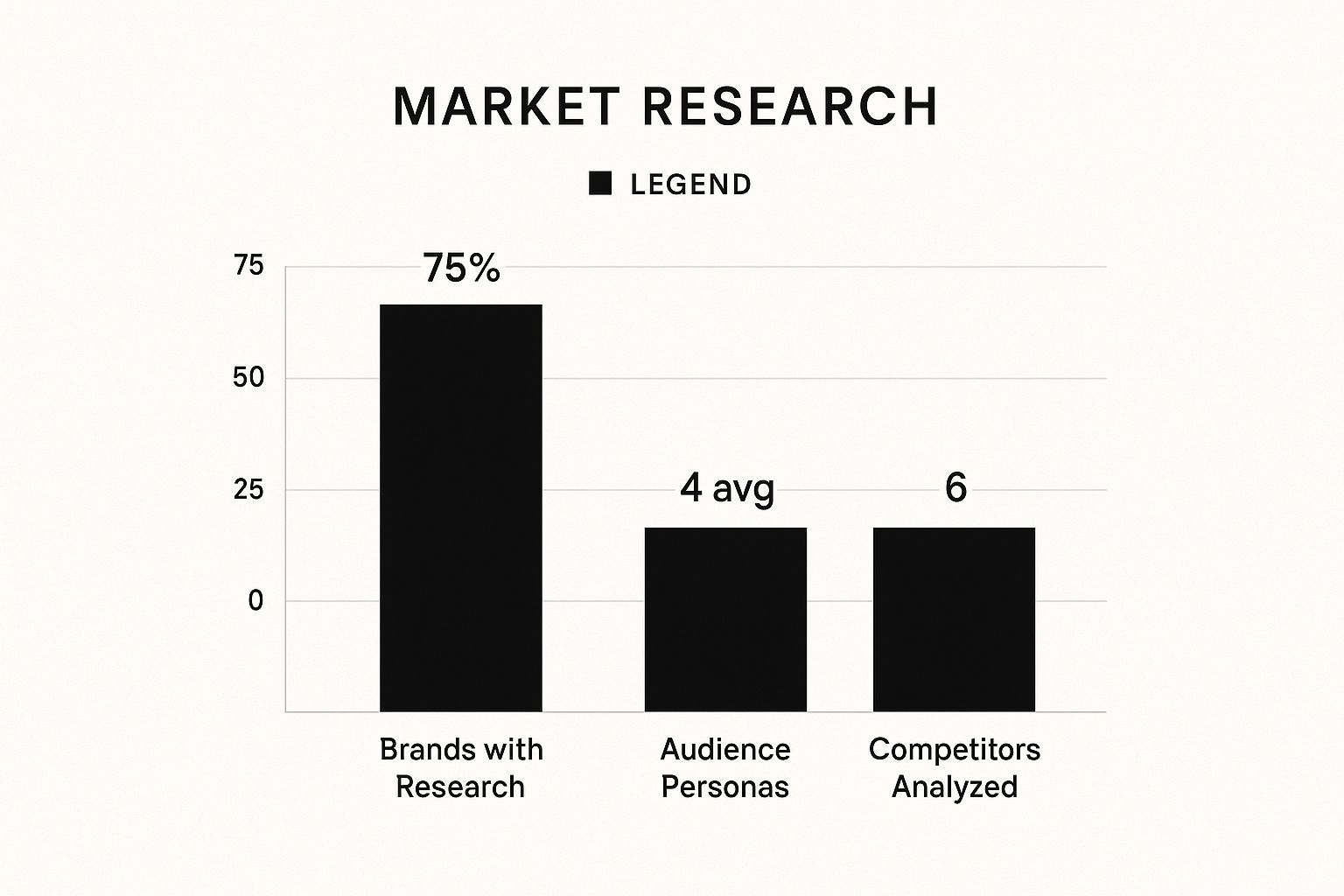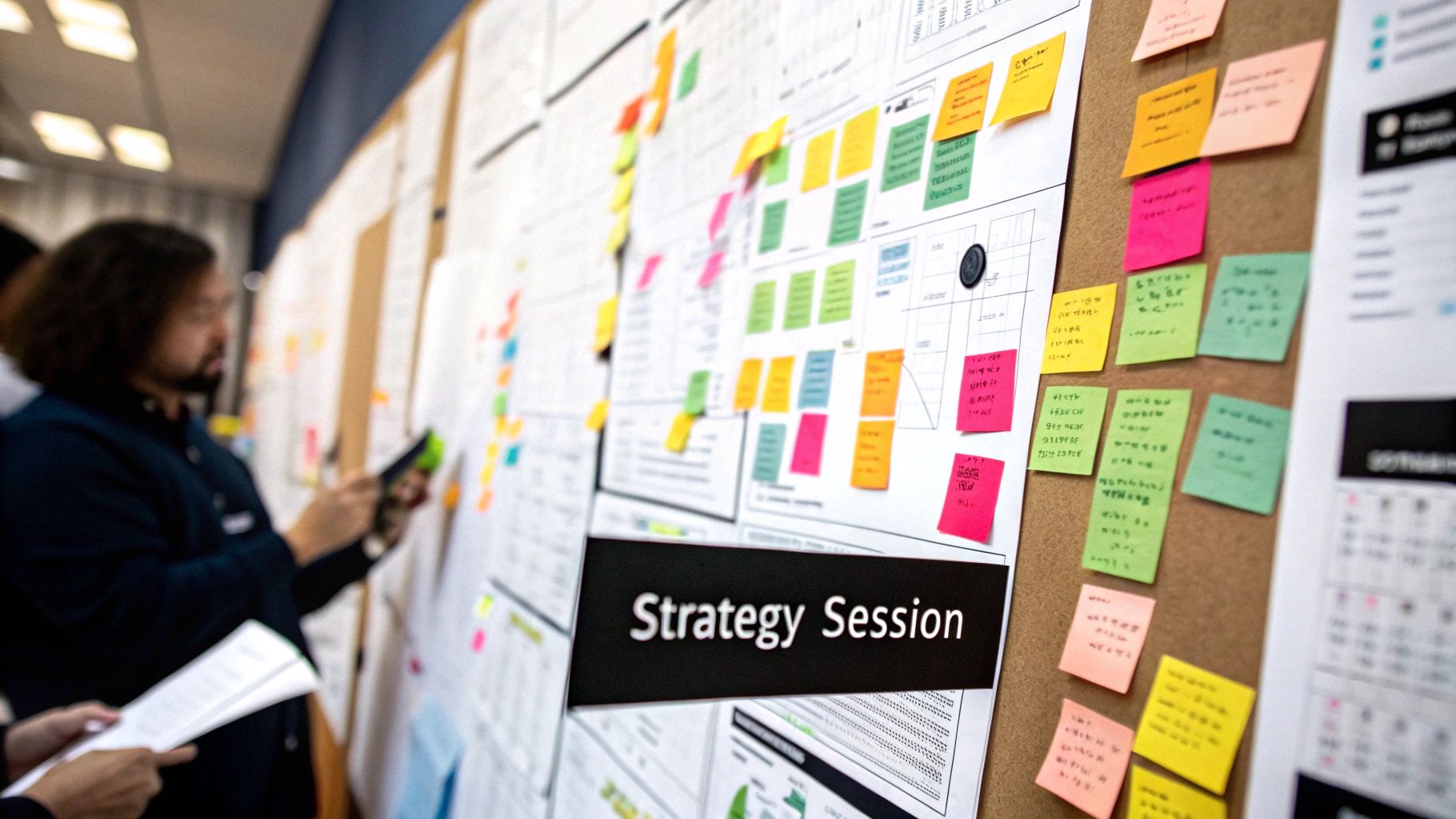The Truth About Branding: Beyond Logos and Colors

It's easy to think branding is just about the look – the logo, the colors, the fonts. But many businesses get stuck there. While visuals definitely play a part, real branding goes much deeper. It's the core strategy shaping how people see and interact with your company.
Focusing only on appearances means missing the crucial groundwork needed for genuine connections. This strategic base is what really builds customer loyalty and helps you stand out. It means truly knowing your audience, defining what makes you unique, and delivering consistently on your promises every single time. A slick logo alone just won't cut it.
Why a Systematic Approach Matters
Taking a structured approach to the branding process steps is vital, whether you're a startup or a large corporation. It shifts branding from being just a creative task to a core business strategy. This often starts with context analysis – looking inward at your mission and values, and outward at competitors and market trends.
Building trust is key from the get-go; 81% of consumers say they need to trust a brand before making a purchase. Effective strategies often include defining brand architecture, which clarifies how different products or services relate. Think about how Procter & Gamble manages its portfolio of 25+ sub-brands to keep things clear. Businesses that formalize brand strategy development—setting out their vision, positioning, and identity—achieve 30-50% higher consumer recall compared to those with less structured methods. Explore branding statistics further
Successful brands know this isn't solely a job for the marketing team; it demands cross-functional collaboration. Getting input and ensuring follow-through across different departments leads to more authentic and consistent branding. When branding is treated as a fundamental strategic investment, not just a design project, companies tend to perform better than competitors. Ultimately, strong branding builds tangible business value.
Step 1: Research That Actually Reveals Opportunities

Building a brand people connect with doesn't start with picking fonts or logos. The real work begins much earlier, with solid, insightful research. This first part of the branding process steps involves digging deep to truly grasp the market and your potential place in it. Forget just confirming your assumptions; the goal here is uncovering real opportunities and understanding what makes customers tick.
Good research goes beyond simple facts like age or location. It aims to uncover the emotional drivers behind why people choose one brand over another. Think about understanding their hopes, their frustrations, and what genuinely sways their decisions. Often, this means talking directly to people and asking the right questions, similar to how you might create a detailed customer persona.
Understanding Your Audience and Competitors
Getting to know your audience means doing some structured homework. Think about using methods like:
- In-depth customer interviews: These conversations can reveal subtle feelings and needs that surveys miss.
- Targeted questionnaires: Use these to gather specific details about preferences, problems, and influences.
- Observational studies: Watch how people actually use products or services like yours in their daily lives.
At the same time, keep a close watch on your competitors. Analyzing them isn't about copying what they do. It’s about understanding their strong points, weak spots, and how customers see them. Ask key questions:
- Who are they connecting with effectively?
- What promises do they make (and actually deliver on)?
- Where are the gaps in what they offer that your brand could fill?
To help you decide which research methods align best with your goals, budget, and timeline, the following table compares common approaches.
Brand Research Methods Comparison
Compare different research methodologies to identify which approaches best fit your branding objectives
| Research Method | Best For | Time Investment | Cost Range | Insight Value |
|---|---|---|---|---|
| Customer Interviews | Deep understanding of motivations, emotions | High | Medium – High | Very High (Qualitative) |
| Targeted Questionnaires | Specific data, preferences, pain points | Medium | Low – Medium | High (Quantitative) |
| Observational Studies | Real-world behavior, usability insights | High | Medium – High | High (Contextual) |
| Competitor Analysis | Market positioning, strengths/weaknesses | Medium | Low – Medium | Medium (Strategic) |
| Market Trend Reports | Broader industry shifts, future outlook | Low | Medium | Medium (Directional) |
| Internal Data Analysis | Existing customer behavior, sales patterns | Low – Medium | Low | Medium (Operational) |
This comparison highlights that deeper insights often require more time and potentially higher costs (like interviews), while broader data (like questionnaires or trend reports) can be gathered more quickly and affordably. A mix of methods usually provides the most robust understanding.
Uncovering Insights with Data
Collecting information is just the start; the real magic happens when you analyze it to spot opportunities. To see where businesses typically uncover these vital insights, let's look at the data chart presented earlier. It breaks down the main sources companies use for identifying brand opportunities.
The chart clearly shows that Customer Feedback is a primary source, relied upon by 45% of businesses searching for insights. This really highlights how crucial direct conversations, surveys, and reviews are. However, leaning on just one source can give you a skewed view. The data also points to significant use of Competitor Analysis (30%), followed by Market Trend Reports (15%) and Internal Data (10%).
Ultimately, using several research methods gives you the richest insights, helping to confirm findings and build a well-rounded picture. It's worth noting that 77% of marketing leaders agree that strong branding, fueled by this type of research, is essential for growth.
Documenting for Action
Everything you learn during this research phase needs to be clearly documented. This ensures it actively guides the next branding process steps. You might create detailed customer personas, profiles of key competitors, maps highlighting market opportunities, or even early mood boards capturing the vibe you want to create.
These documents become your reference points, making sure your strategy stays grounded in real market understanding. Be cautious of research that merely echoes what you already thought. Genuine insights often challenge your assumptions, paving the way for more unique and impactful brand strategies. If you need help with this crucial step, platforms like Creativize can connect you with branding experts who excel at conducting and interpreting research.
Step 2: Crafting a Brand Strategy That Actually Differentiates

Alright, you've done your homework and found some real opportunities. Now it's time for the next part of the branding process steps: building a strategy that makes your brand stand out. This isn't about fuzzy mission statements or generic company values nobody remembers. It’s about setting a clear direction that shapes every choice you make, helping your brand claim a unique spot in your customers' minds.
Think of a solid brand strategy as your North Star. It guides your efforts, keeping everything consistent and focused. It takes all those juicy insights from Step 1 and turns them into practical guidelines that set you apart from the crowd in ways that matter. Without this core strategy, your branding can end up feeling random or easily copied.
Key Pillars of a Differentiating Strategy
To carve out a distinct space in the market, your strategy needs these core pieces:
- Brand Purpose: Why do you exist, beyond making money? What big problem are you solving, or what dream are you helping people reach? This is the fundamental belief driving your business.
- Brand Positioning: Looking at your research, where do you fit in the competitive scene? What specific angle or niche can you truly own? This determines how you want your ideal customers to see you compared to other options.
- Brand Personality: If your brand walked into a room, what would it feel like? Would it be quirky and forward-thinking, or steady and trustworthy? This sets the tone for how you communicate.
- Brand Promise: What specific value or experience can customers count on getting from you, every single time? This is the real-world benefit you commit to delivering.
These pieces fit together to create the heart of your brand identity, going much deeper than just surface-level slogans.
Identifying What Makes You Genuinely Unique
It's easy to fall into the trap of saying you're different because of "great quality" or "top-notch service." While those things are important, they're often just the price of entry – things customers expect from everyone, including your competitors. Real differentiation comes from pinpointing what makes you truly unique and hard to imitate.
Consider the special mix of your skills, your core values, what your audience genuinely needs, and the market gaps you spotted during research. Maybe it’s a unique way you do things, a fresh take on customer support, or a strong commitment to a cause that really connects with your audience. Successful brands find that sweet spot between aspiration (where they want to go) and authenticity (what they can realistically deliver today).
Before you dive in headfirst, it's smart to put your strategy to the test. Does it click with your team? Getting your employees on board is key; companies with strong internal agreement often see 2-4x faster growth in brand value. Does it make sense to your target customers? Getting feedback early can save you from expensive mistakes later. If you need an outside eye to help shape and test your ideas, platforms like Creativize connect you with experienced brand strategists. Keep an eye out for warning signs like confusion internally or customer comments that don't match your intended image – these might mean it's time to adjust your course.
Step 3: Developing Visual Identity That Captures Your Essence

Okay, you've mapped out your brand strategy in the previous branding process steps. Now it's time to give it a look! This stage turns those ideas about your brand's purpose and personality into things people can actually see and connect with. It’s about creating a visual style that genuinely reflects what your brand stands for.
Sometimes, businesses get caught up chasing the latest design trends or just go with whatever the designer likes best. This can lead to visuals that look nice but don't actually match the brand's strategy. A strong visual identity isn't just about looking good; it needs to clearly show your brand's unique spot in the market and its core values.
Core Components of a Visual System
Think of your visual identity like a complete toolkit, not just a collection of random pieces. The main parts work together:
- Logo: This is your main visual signature. It has to stand out, be easy to remember, and look good everywhere, big or small.
- Color Palette: Colors create feelings and connections. Your chosen colors should match your brand's personality and help you look different from competitors.
- Typography: The fonts you pick set the tone and affect how easy things are to read. Think about using different fonts for headlines, regular text, and action buttons.
- Imagery Style: Having clear rules for photos, illustrations, or icons keeps things consistent and reinforces your brand's character.
Ensuring Strategic Alignment and Consistency
Putting these elements together takes focus. Work closely with your designers. Give them clear direction based on your strategy, but also give them space to be creative. Use your strategy documents to judge design ideas objectively – don't let personal taste get in the way of what works strategically. Does the logo work in different places? Do the colors feel right for the brand personality?
Making your brand strategy execution work visually really depends on being consistent everywhere – your website, social media, packaging, presentations, you name it. Consistency builds recognition and makes people trust your brand. Getting your team on board is also key; companies where employees understand and support the brand often see 2-4x faster growth in brand equity.
For instance, big rebranding projects that include training for staff tend to get 20-40% higher scores on how people outside the company see them. Since about 50% of consumers follow 1-4 brands on social media, tailored communication plans and consistent visuals are really important. Keep in mind that design elements like logos and packaging can make up 15-25% of your initial branding budget, so making smart choices matters. Explore the stages of branding further
Your goal is a visual identity system that’s flexible enough for different situations but structured enough to stay consistent and recognizable over time. This visual language is how your audience gets to know and experience your brand.
Step 4: Building a Messaging Framework That Resonates
Okay, your brand's look is coming together. Now, it's time to give it a voice. Just like visuals, the words you choose are essential for turning your strategy into something real that connects with people. This is a key part of the branding process steps.
A solid messaging framework acts as your brand's script. It makes sure everything you say sounds like you, matches your visuals, and lines up with what your brand stands for. Without this guide, your messages can feel scattered or confusing, making your brand less impactful.
Defining Your Core Messages
Think of core messages as the big ideas you want people to remember about your brand. They go deeper than just a catchy tagline. You'll want to nail down things like:
- Your Value Proposition: What unique benefit do you offer? Why pick you instead of the competition? State it clearly.
- Your Brand Story: Share where you came from, what drives you, and what you believe in. Make it interesting!
- Key Message Points: Create short, punchy statements based on your main strategy. These should address specific customer needs or highlight product features.
Developing these means taking your earlier strategic thinking and putting it into words that click with your audience, both logically and emotionally.
Ensuring Consistency and Adaptability
Consistency builds trust and makes your brand recognizable. In fact, 77% of marketing leaders agree that strong, consistent branding is crucial for growth. Your messaging framework is the tool that keeps everyone on the same page.
This involves setting up:
- Message Hierarchies: Figure out which messages are most important overall and which ones are better for specific campaigns or platforms.
- Tone of Voice Guidelines: Decide on your brand's personality. Are you serious and authoritative? Fun and friendly? Witty? Define it so everyone writing for the brand sounds consistent.
- Audience Adaptations: Create guidelines for tweaking messages for different groups (like potential customers vs. loyal ones) or channels (like social media vs. detailed reports) while keeping the core voice intact.
To help organize these components, here’s a breakdown of what goes into a typical messaging framework:
Brand Messaging Framework Elements
Overview of essential components in an effective brand messaging strategy
| Framework Element | Purpose | Target Audience | Development Process | Implementation Tips |
|---|---|---|---|---|
| Value Proposition | Articulate core unique benefit | Primary Customers | Distill research & strategy; competitive analysis | Use consistently in high-level communications |
| Brand Story | Build emotional connection, explain purpose | All Stakeholders | Define narrative arc based on brand origins & values | Weave into 'About Us', onboarding, key presentations |
| Key Message Pillars | Define 3-5 core themes supporting the value prop | Specific Segments / Campaigns | Group related benefits/features under strategic themes | Guide content creation for marketing materials |
| Tone of Voice | Establish consistent brand personality | All Audiences | Define attributes (e.g., playful, expert); provide examples | Train team; use in style guides; review content regularly |
| Proof Points | Provide evidence (stats, testimonials) backing up claims | Skeptical / Detail-Oriented | Gather data, case studies, customer quotes | Use strategically in sales materials, landing pages |
| Audience Variants | Tailor messages for specific needs/perspectives | Defined Audience Segments | Map core messages to segment pain points/interests | Develop segment-specific communication guides |
This table highlights the essential building blocks. Each element plays a specific role in making sure your brand communicates effectively and consistently across the board.
Testing and Training for Fluency
Before you go all-in with your new messaging, test the key parts. Talk to people who represent your target audience and see if the message lands the way you want it to. Their feedback is gold for catching misunderstandings.
Finally, train your internal teams. Your sales, marketing, and customer service folks especially need to get comfortable speaking the brand's language. When everyone sounds united and genuine, it strengthens the brand identity you've worked hard to build through these important branding process steps. Keep an ear out for feedback later on – if people are confused, it might be time to tweak your messages.
Step 5: Implementing Your Brand with Maximum Impact
Okay, so you've got a solid strategy and some eye-catching visuals. But that's just the starting line. The real work begins during implementation – this is one of the most vital branding process steps. It's where your brand stops being an idea and starts showing up wherever customers interact with you.
A thoughtful rollout ensures all your planning translates into real-world results, building momentum effectively.
Prioritizing Your Brand Touchpoints
Not every customer interaction carries the same weight. Begin by mapping out the typical customer journey. This helps you see where your brand can make the strongest initial impression.
Through this exercise, you'll spot the key touchpoints – places like your website, social media presence, how your team handles customer service, or even your product packaging. These are the interactions that really stick with your audience.
Think about using a phased approach for introducing your brand changes. This helps you allocate resources wisely and lets your audience get familiar with the new brand gradually, rather than hitting them with everything at once. Maybe start with your digital presence before tackling physical items or major ad campaigns.
Turning Employees into Brand Ambassadors
Your team members are probably your most significant brand touchpoint. Every day, their actions and conversations shape how customers see your business. Transforming employees into enthusiastic brand ambassadors is essential for bringing your brand to life.
This means doing more than just emailing a style guide. Set up training sessions to walk everyone through the brand strategy, its core values, and the key messages. Give them the tools and understanding they need to represent the brand naturally. Genuine internal buy-in leads to better, more authentic customer experiences. Happy employees often mean happy customers.
Managing the Change Process Smoothly
Launching a new brand identity or updating an old one always brings change. This can be tricky, particularly for businesses that have been around for a while. Good change management hinges on clear communication with everyone involved: your team, your customers, your partners, and investors.
Create specific launch plans for each group. Explain why the changes are happening and what the upsides are. It's also smart to establish clear brand governance right away. This involves setting up guidelines and review processes to keep the brand consistent as different teams and external partners start using the new elements. This structure keeps your brand strong and unified as you move forward.
If you need help finding creative talent to handle parts of the implementation, platforms like Creativize can connect you with local professionals.
Step 6: Measuring Brand Performance That Actually Matters
Getting your brand out into the world is a major milestone in the branding process steps. But the work doesn't stop once everything is live. To really know if your branding efforts are hitting the mark, you need to look past the surface numbers. Smart measurement focuses on what truly shows your brand's health and how it connects to real business outcomes.
It's easy to get caught up tracking things like website visits or social media likes – sometimes called vanity metrics. While they might look good, they don't tell the whole story. Truly understanding your brand's performance means looking deeper. Successful brands set up ways to measure their impact all the way through the customer journey, from someone first hearing about them to becoming a loyal fan.
Tracking What Counts: Key Brand Metrics
Instead of just tallying clicks, concentrate on signs that reveal how people actually see and value your brand. Think about metrics like these:
- Brand Awareness & Recall: Do people know your brand exists? Does it come to mind when they think about products or services like yours? You can figure this out using surveys or by looking at how often people search for your brand name online.
- Brand Perception & Sentiment: What's the general feeling about your brand? Keep an eye on online chats, customer reviews, and use sentiment analysis tools to get a sense of public opinion.
- Purchase Intent & Preference: Are potential customers thinking about choosing your brand when they're ready to buy? Tracking things like leads, requests for quotes, or how many people add items to their cart can give you clues.
- Customer Loyalty & Advocacy: Do your customers stay with you? Do they recommend you to others? Metrics like Net Promoter Score (NPS), customer lifetime value, and how often customers buy again are really important here. Remember, consistency is key; 77% of marketing leaders agree that strong branding is crucial for growth.
Conducting Periodic Brand Audits
Markets change, and what customers want evolves. Taking a step back regularly to conduct a brand audit helps you make sure your brand is still on track. This means systematically checking how your brand is doing compared to its goals and what competitors are up to.
An audit points out what's working well, areas that need improvement, and maybe even new ways to polish your brand. It helps ensure your brand stays relevant and connects with people, striking a balance between staying consistent and making necessary updates. This forward-thinking approach keeps your branding sharp and effective.
Measuring your brand's performance isn't just about justifying budgets; it's about continuous learning and improvement. These insights feed the ongoing tweaks needed to keep your brand strong and ensure all the branding process steps build towards long-term success.
Need a hand figuring out how your brand is really doing or want expert help refining your strategy with data? Check out the talented professionals on Creativize to get valuable insights.

